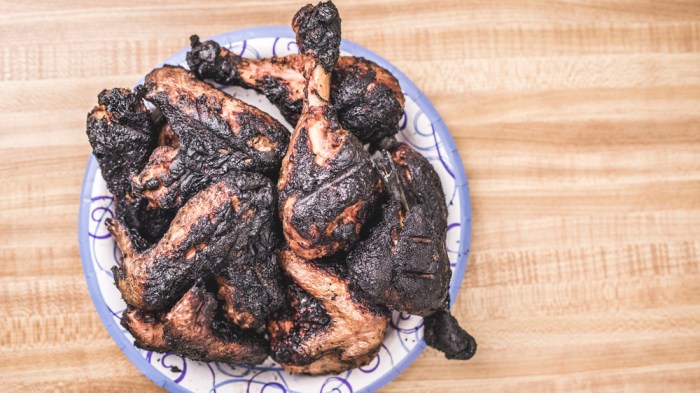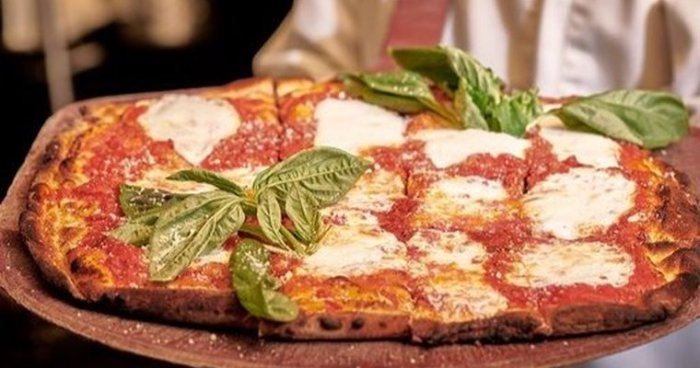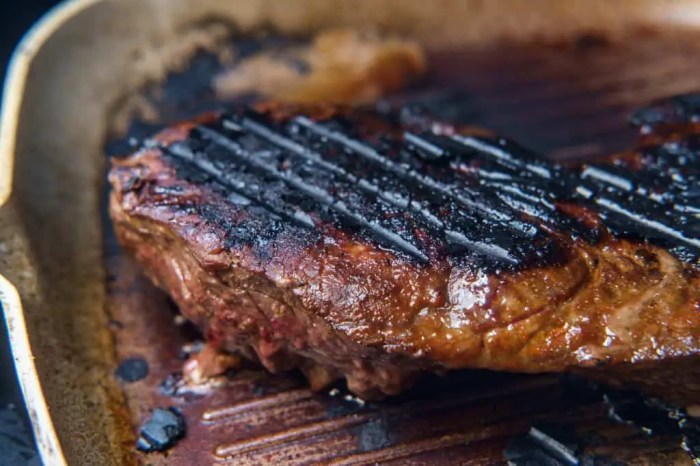Flash fired vs charred wings – Prepare your taste buds for a tantalizing culinary adventure as we delve into the world of flash fired vs. charred wings. These two distinct cooking techniques transform ordinary chicken wings into extraordinary flavor sensations, each boasting its own unique allure.
Flash firing, a method that involves cooking wings at high temperatures for a short duration, yields crispy exteriors and juicy interiors. Charring, on the other hand, involves exposing wings to lower temperatures for an extended period, resulting in a smoky, caramelized finish.
Definition of Flash Fired vs. Charred Wings: Flash Fired Vs Charred Wings
In the culinary world, flash firing and charring are two distinct techniques used to cook chicken wings. While both methods involve exposing the wings to high heat, the duration and intensity of the heat determine the final result.
Flash Firing
Flash firing is a technique that involves exposing the wings to intense heat for a short period, typically around 2-3 minutes. This quick and high-heat cooking method results in a crispy exterior while leaving the interior of the wings juicy and tender.
The wings are usually tossed in a flavorful sauce before being flash-fried.
Charring
Charring, on the other hand, is a technique that involves cooking the wings over a lower heat for an extended period, typically around 10-15 minutes. This slower and gentler cooking method results in a smoky and charred exterior with a tender and flavorful interior.
The wings are usually seasoned with a dry rub before being charred.
Methods and Procedures
Achieving the perfect flash-fired or charred wings requires precise techniques and attention to detail. Here’s a step-by-step guide to master both methods:
Flash Frying
Flash frying involves cooking the wings at a high temperature for a short period, resulting in crispy skin and juicy interiors. Follow these steps:
- Season the wings generously with salt, pepper, and your preferred spices.
- Heat a large skillet or deep fryer to 375°F (190°C).
- Carefully add the wings to the hot oil and cook for 5-7 minutes, or until golden brown and cooked through.
- Remove the wings from the oil and drain on paper towels.
Charring
Charring involves cooking the wings over high heat for an extended period, creating a smoky, caramelized exterior and tender meat. Here’s how:
- Preheat your grill or oven to 400°F (200°C).
- Season the wings with salt, pepper, and any desired spices.
- Place the wings on the grill or baking sheet and cook for 15-20 minutes, or until charred and cooked through.
- Baste the wings with your favorite sauce during the last 5 minutes of cooking for added flavor.
Adjust the cooking times slightly depending on the size and quantity of wings to achieve the desired level of doneness and texture.
Equipment and Ingredients

For flash-firing, an oven or broiler is typically used. These provide intense heat to quickly sear the surface of the wings without overcooking the interior. A grill can also be used, but the heat distribution may not be as even as with an oven or broiler.
Charring wings requires a grill or open flame. The direct heat from the flame will create the desired charred exterior.
The ingredients for both techniques are similar: chicken wings, salt, and pepper. For flash-firing, a marinade or rub can be used to add flavor. For charring, a sauce or glaze can be applied after cooking to add moisture and flavor.
Essential Equipment
- Oven or broiler (for flash-firing)
- Grill or open flame (for charring)
- Baking sheet or grill grate
- Tongs or spatula
Flavor Profiles and Seasonings
Flash fired and charred wings boast distinctive flavor profiles that cater to diverse taste preferences. Let’s delve into their unique characteristics and explore the seasonings that complement them best.
Flash-fired wings, cooked rapidly over high heat, exhibit a crispy exterior and a juicy, tender interior. Their flavor is delicate, allowing the natural taste of the chicken to shine through. Seasonings like salt, pepper, garlic powder, and paprika enhance their subtle flavor without overpowering it.
Sauces for Flash-Fired Wings
- Buffalo sauce: A classic pairing, providing a tangy and spicy kick.
- Honey mustard: A sweet and tangy sauce that complements the crispy texture.
- Barbecue sauce: A smoky and savory sauce that adds depth to the wings.
Charred wings, on the other hand, are cooked over low heat for an extended period, resulting in a smoky, caramelized exterior and a fall-off-the-bone tenderness. Their intense flavor can handle bolder seasonings, such as chili powder, cumin, smoked paprika, and brown sugar.
Sauces for Charred Wings
- Sweet and spicy sauce: A combination of honey, sriracha, and soy sauce that provides a balance of sweetness and heat.
- Teriyaki sauce: A savory and slightly sweet sauce that adds a glaze to the wings.
- Mustard-based sauce: A tangy and flavorful sauce that complements the smoky flavor of the wings.
Texture and Appearance

Flash fired and charred wings exhibit distinct differences in texture and appearance due to variations in cooking time and temperature.
Flash fired wings are characterized by a crispy, golden-brown exterior with a juicy and tender interior. The high heat and short cooking time result in a thin, crisp crust that locks in the moisture, preventing the wings from drying out.
The interior remains tender and succulent, with a slight pink hue indicating doneness.
Flash-fired wings bring a crisp and juicy bite, while charred wings offer a smoky, caramelized flavor. Just like the you turned the page shirt that flips between casual and formal with ease, these wing variations cater to diverse tastes. Flash-fired wings maintain a tender interior, while charred wings develop a slightly chewy texture, adding depth to their flavor profile.
Charred Wings
In contrast, charred wings possess a smoky, caramelized exterior with a more pronounced crunch. The extended cooking time and lower heat allow the sugars in the chicken skin to caramelize, creating a deeply flavorful and crispy crust. The interior is cooked through, but remains moist and slightly chewy due to the slower cooking process.
Presentation and Serving Suggestions
The presentation of your wings can enhance their visual appeal and make them more tempting to diners. Consider using colorful garnishes, arranging the wings in a creative way, and serving them with dipping sauces or sides that complement their flavors.
To complement the bold flavors of flash-fired or charred wings, consider serving them with refreshing side dishes such as coleslaw, potato salad, or fresh vegetables. For a more indulgent experience, pair them with creamy dips like ranch or blue cheese dressing.
Garnishing Techniques
- Sprinkle fresh herbs such as cilantro, parsley, or chives over the wings.
- Add a drizzle of a flavorful sauce, such as honey mustard or barbecue sauce, to create a glaze.
- Garnish with sliced scallions, red onions, or pickled jalapeños for a pop of color and extra flavor.
Health Considerations

Consuming flash fired or charred wings may have different health implications. It’s essential to be aware of the potential nutritional benefits and risks associated with each technique.
Flash firing involves cooking the wings at high temperatures for a short duration, while charring involves cooking them at lower temperatures for an extended period. Both techniques can result in the formation of compounds that may have health implications.
Nutritional Value
- Flash Fired:Flash-fired wings tend to have a lower fat content than charred wings due to the shorter cooking time. They also retain more of their original nutrients, such as vitamins and minerals.
- Charred:Charred wings may have a slightly higher fat content due to the longer cooking time. However, they may also contain higher levels of certain antioxidants and other beneficial compounds.
Risks
- Flash Fired:Flash-fired wings may contain acrylamide, a compound that has been linked to an increased risk of cancer. However, the levels of acrylamide in flash-fired wings are typically lower than in other fried foods.
- Charred:Charred wings may contain polycyclic aromatic hydrocarbons (PAHs), which are compounds that have been linked to an increased risk of cancer. The levels of PAHs in charred wings vary depending on the cooking method and the amount of charring.
Additional Notes

In addition to the information provided above, here are some additional notes that may be helpful:
When flash frying wings, it is important to use a high heat setting and cook the wings quickly. This will help to create a crispy exterior while keeping the interior juicy. If the wings are cooked too slowly, they will become tough and chewy.
When charring wings, it is important to use a lower heat setting and cook the wings slowly. This will allow the wings to develop a smoky flavor and a crispy exterior. If the wings are cooked too quickly, they will become burnt.
Both flash fired and charred wings can be seasoned with a variety of spices and herbs. Some popular seasonings include salt, pepper, garlic powder, onion powder, paprika, and chili powder.
Flash fired wings are typically served with a dipping sauce, such as ranch dressing or blue cheese dressing. Charred wings can be served with a variety of dipping sauces, including barbecue sauce, honey mustard, or sweet and sour sauce.
Both flash fired and charred wings are delicious and versatile dishes that can be enjoyed by people of all ages.
Personal Experiences, Flash fired vs charred wings
I have personally tried both flash fired and charred wings, and I enjoy both styles. I find that flash fired wings are a great option when I am looking for a quick and easy meal. Charred wings are a great option when I am looking for a more flavorful and smoky dish.
FAQ Section
What is the key difference between flash fired and charred wings?
Flash fired wings are cooked at high temperatures for a short duration, resulting in crispy exteriors and juicy interiors, while charred wings are cooked at lower temperatures for an extended period, giving them a smoky, caramelized finish.
Which technique is healthier?
Flash firing is generally considered healthier as it involves less time spent at high temperatures, which can reduce the formation of harmful compounds.
Can I use the same seasonings for both flash fired and charred wings?
Yes, you can use the same seasonings for both techniques, but charred wings may benefit from additional smoky or earthy flavors.